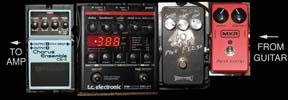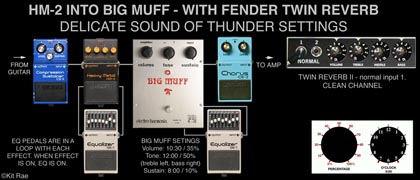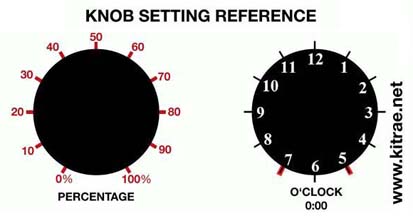NOTE: This website is frequently updated. Last update 2011
ON THE TURNING AWAY SOLO / PINK FLOYD - Here is my gear and attempts at this amazing David Gilmour solo tone. The original song is a classic and the solo ranks up there with David's Comfortably Numb outro solo. From all accounts, Gilmour likely used a blended distortion-overdive for the solos on Pink Floyd's Momentary Lapse of Reason studio recording. The Boss HM-2 was sent into the Gallien-Krueger 250ML, which was set with a slightly dirty overdive. David used the HM-2 and a Ram's Head Big Muff for the live 1987 tour, and switched the Big Muff for a Cornish P-2 for the 1988 and 1990 tour dates, captured on the Delicate Sound of Thunder album. For the later 1994 Pulse tour David switched to a Sovtek Civil War Big Muff for this song.
For my rig I was going for more of the Momentary Lapse of Reason / Delicate Sound of Thunder live tone. Any decent Big Muff type pedal with a deep bottom end and brighter mid range, such as a 1990s Sovtek Big Muff, will work. The old Red Army Overdrive, Civil War Big Muff, green Sovtek Big Muff, or the later Black Sovtek, Bass Big Muff, or Deluxe Bass Big Muff are all perfect for that tone. A good Big Muff clone like the DG-1 Drivegate from TopTone, Stomp Under Foot CWM, or Pete Cornish P-2 are good choices as well. I have a section on all of the Big Muffs HERE. I also have a detailed section on getting this particular tone HERE.
A Boss chorus like the old CE-2, CE-3, or later CE-5 is needed for the smooth modulation you hear, and these units work perfectly with vintage Big Muffs, enhancing their tonal characteristics. Some compression and/or a booster pedal to add some gain is also a good idea to achieve this tone if you are using a Sovtek Big Muff, and a slight mids boost, from an EQ to simulate the tone circuit of David's EMG pickups helps. For delay, I use a TC Electonic Nova delay with a warm analog setting, about 3-4 repeats, at 410ms to 440ms. Any good, warm sounding digital or analog delay will work. Some good ones are the old Boss DD-2, DD-3, DD-20, Ibanez DE-7, and the TC Electonic Nova delay. All are good, warm sounding digital delays, with the old DD-2 being my favorite. The Electro-Harmonix Deluxe Memory Man and MXR Carbon Copy delays are two other good analog delays that have a warm tape delay sound.
I used a 2008 American Standard Strat with Seymour Duncan SSL-5 bridge pickup into a clean '65 Fender Twin Reverb re-issue. The backing track is from Gilmourish.com, but I have extended it a bit to make a longer solo. My GE-7 is set for a mid range cut here, as it works better for my rig, but you may want to try setting the sliders the exact opposite of this for your rig.
On the Turning Away Solo - MXR Dynacomp > Skreddy Pink Flesh > Boss CE-5 > TC Electonic Nova delay (The audio quality is kind of crappy in this clip, recorded with a camcorder)
Another easy way to get the DSOT live lead solo tones is to use the Boss HM-2 as a driver into a Ram's Head Big Muff, through a Fender Twin Reverb. The HM-2 is an excellent booster into a Big Muff for DSOT tones, and this combo is a true blend of the characteristics of both pedals. Set the HM-2 as shown in the photo below. The HM-2 is the driver and the muff is the EQ in this combo, so the muff sustain needs to be set very low, around 9:00. The muff tone circuit is interactive with the sustain, so as you turn the sustain down, turn the tone up the same amount (treble side). I keep mine about 3:00, but adjust until it sounds right on your amp. Having a compressor on the front end helps, but you don't really need the EQ pedal unless you think you need a slight mids boost. I use the Boss CE-2 or Boss CE-5 for the lush chorus effect, in place of the SPX-90 II that David used.
One drawback to this combo is that it only sounds like DSOT when running it into a clean, mid scooped Fender amp, like the Fender Twin Reverb. It does not sound as good into amps with more mid range, like the Hiwatt DR103 or Reeves.
THE STUDIO RECORDED SOLO - To match the studio recorded guitar solo tone from Momentary Lapse of Reason, I use my Strat equipped with EMG-SA pickups (SPC:6, EXG:1), into a Boss CS-2 Compressor, the old Boss HM-2, a BK Butler Tube Driver set for a very light drive boost, delay, and a Boss CE-2 chorus (in that order). I use a gentle curve of the sliders on the GE-7, starting at zero on the ends, and curving up to just past the first notch in the middle. What David actually used in the studio is a bit more complicated, but the basic setup for most of the guitar solos on the album seems to be a two-amp setup, with two separate distortion tones, mixed together for the final sound. David has done this type of thing going all the way back to Pink Floyd's Animals album.
GUITAR - The guitar used was either David's '57 reissue Fender Strat or his Steinberger GL3T, both equipped with EMG-SA active pickups. David used the SPC control of the EMG pickups to boost the low mid range. He often set this around 5 when playing live, and it seems the EXG control was always set to 1 and not used.
SIGNAL CHAIN, EFFECTS AND AMPS - The guitar signal goes to a stereo volume pedal, where it splits into two separate signal chains, going to two different amplifiers. One side goes to a Gallien Kreuger 250ML amp, using the distortion channel (and probably the built in chorus), and a delay (probably the MXR). The other side goes into a Boss CS-2 compressor, Boss HM-2 distortion pedal, Boss GE-7 equalizer (most likely set for a mid range boost), a Boss DD-2 delay, a Boss CE-2 chorus, into a clean Fender Super Champ amp. Those two amplifiers were mic'd separately, then blended together to make the final mix. I believe this setup, or something similar, was used for just about every guitar solo on a Momentary Lapse of Reason. A Big Muff may have been used instead of the HM-2 for the guitar solo in Sorrow.
This type of setup is also similar to what David had been using just prior to A Momentary Lapse of Reason. There are various accounts of what David used in the Momentary sessions, must referring to the song Sorrow. This is what David said he used in 1988, so it was fresh in his memory, but he is only talking about the intro here:
"That very nasty distortion you hear at the beginning of the song (Sorrow) is basically the result of the Steinberger going through two little amps in the studio - a Fender Super Champ and a Gallien-Krueger. I use a Boss Heavy Metal distortion pedal (HM-2) and a Boss digital delay pedal (DD-2), which then goes into the Fender Super Champ. And that in combination with the internal distortion on the Gallien-Krueger was how I got that particular sound."
Richard Mahon, a Pink Floyd historian and author, detailed te setup a bit more on his webiste, with information that I think he got from Gilmour's gear tech, Phil Taylor. He refers to the Sorrow Intro here, but he also says this was the main setup for A Momentary Lapse of Reason:
"The guitar signal was split by a stereo volume pedal into two delay pedals. The volume pedal also ran between the pre-amp and power amp of the first feed--into a Gallien-Krueger 250ML amplifier. The second feed was sent to a Boss HM-2 Heavy Metal pedal into a Boss GE-7 graphic equalizer then into a Fender Super Champ amplifier. The main guitar track of "Sorrow" was recorded this way. This was the basic setup for most of the album. The (Sorrow) intro was a Steinberger plugged into a Big Muff then a Fender Concert amp. Gilmour took the tapes and ran the intro through a loudspeaker setup at the Los Angeles Sports Arena."
Phil Taylor states is a bit differently in his Black Strat book:
"David recorded the guitar parts and solo from Sorrow from A Momentary lapse of Reason on it (Steinberger with EMG-SA's), playing through a Big Muff distortion pedal, MXR delay, Gallien Kruger ML250, and Fender Super Champ amplifiers."
So Richard and Phil both say the intro and solo was a Big Muff, but David said it was an HM-2. I think the Big Muff was substituted for the HM-2 on some songs, but I happen to think the HM-2 was used for just about everything on that record, including On the Turning Away, as that is what it sounds like. Richard's information indicates the GK amp was a separate signal chain, not fed by the HM-2, and David said the GK amp was set for distortion. This makes the Gallien Kruger amp distortion also an essential part of that tone, although it is hard to say if the HM-2 and GK distortions were mixed evenly, or one was more dominant than the other. I suspect it varied from song to song, but for On the Turning Away, I think the HM-2 was more dominant. You will always see a GE-7 or two beside the HM-2 in David's rig photos from this era, used to lightly sculpt the sound EQ. In this case, I think it is a mid range boost. That and the SPC low mid range boost control are giving it that bright tone that some people associate with a fixed wah filter sound, so this is also a key element to the tone, as is the chorus.
RETURN TO GILMOUR TONE BUILDING HOME
Kit’s Secret Guitar, Gear, and Music Page
Guitar stuff, gear stuff, soundclips, videos, Gilmour/Pink Floyd stuff, photos and other goodies.
Copyright Kit Rae.
VISIT MY SWORDS, KNIVES and FANTASY ART WEBSITE www.kitrae.net






















